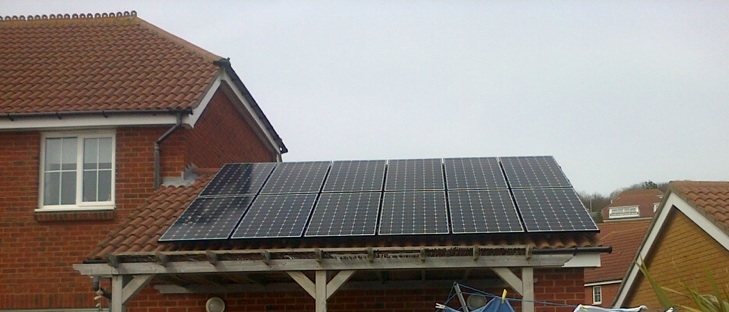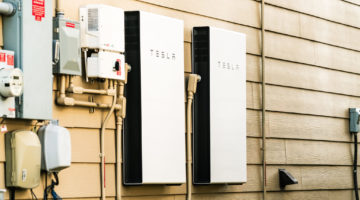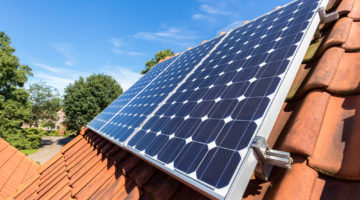
As part of the Green Deal, I am going to a lot homes at the moment and solar PV tends to come up a lot. People are unsure about how the numbers stack-up, they have heard in the news about the recent drop in the Feed-in-Tariff payments, but they are also aware that energy prices are going up substantially every year. So is getting solar PV installed on your home still worth it?!
In a word – Yes!
But the speed of payback is actually fairly dependant on when you use the energy, as you will see in a minute. So here goes and if you want to query any of the numbers, please drop a comment at the bottom of this post. A typical system is about 3.6kW (3,600 watts) in size, which will cost you approximately £6,000.
How much electricity will your Solar PV system Generate?
If you take this figure (or the size of the system you are interested in getting – obviously the bigger it is the more electricity it can produce) and multiply it by 0.8 it will give you the approximate number of kWh the system produces in a year, so in this case a 3.6kW system would work out as follows.
So 3600 x 0.8 = 2880kWh
To give you a rough guide, the average home uses about 4,800kWh each year, although your energy bills will reveal what you actually use.
The Generation Tariff – payment for every kWh of electricity produced
As part of the Feed-in Tariff, the Energy Suppliers are obliged to pay you 15.44 pence for every unit of energy you produce, regardless of what you do with it – this is known as the Generation Tariff and is guaranteed for 20 years, i.e. regardless of whether the FiT drops over the coming years, you will get this payment of 14.90 pence for every kWh you produce.
2880kWh x 14.38 pence = £414.14
But there is more!!
The Generation Tariff is only half the story!
Now unfortunately, as anyone who has done GCSE science will be able to tell you, it is not possible to store electricity so you can either use the electricity as it gets produced by the solar PV system or you can export it back to the electrical grid (you have have battery back-up, however in the UK 99% of homes with Solar PV have grid-tied systems).
The final payback of the system is dependant on the ratio of using the electricity in the home compared to the amount exported.
The Export Tariff – payment for every kWh of electricity exported
For every kWh produced and sold back to the grid you get 4.77 pence (this is known simply as the Export tariff), but for every kWh you can use in the home, it means you don’t need to buy it from the grid at approximately 15.32 pence / kWH.
I hope you can see therefore that it is about 3 times better (financially) to use the electricity you produce rather than export it back to the grid.
Having said all that – it is worth bearing in mind that most residential solar PV systems installed in the UK don’t come with a export meter, so they will simply half the generation meter reading and assume you export that this – this means you will be paid as if you exporting 50% regardless of whether you use all the electricity in the home or none of it.
As a result of this – in an ideal situation you would use 100% of the electricity in the home and you would still be paid as if you were exporting 50% of it to the grid – so a nice little bonus!
In the scenarios below however, I am going to include the export calculations as if you have an export meter, since the move to smart meters will unfortunately remove this nice little bonus!
Maximising the return from your Solar PV investment
So the key here is obviously to have lots of panels, all facing south, and use every kWh of electricity that they produce, however in most cases this simply isn’t feasible.
Imagine being at work all day, your solar system is producing lots of electricity, but you aren’t there to use it. Conversely, a stay at home mum would be much better placed to use all the electricity.
So in the next section I am going to look at 3 scenarios which will determine the amount of electricity a household can use in the home and how much they need to sell (remembering you can’t store the electricity), and therefore their total yearly return from installing a 3.5kW solar system within their home.
Scenario 1 (Parents both working, children at school)
In this scenario, it makes sense that the family will only be able to use their energy early in the morning and when they get home in the evening (obviously they can set washing machines / dishwashers to run as they leave the house), but lets say they use 25% and sell 75%.
Export tariff – 75% x 2880kWh x 4.77 pence = £103.03
Saving on Energy Bill – 25% x 2880kWh x 15.32 pence = £110.30
Total Yearly Return = £414.14 + £103.03 + £110.30 = £627.47
Scenario 2 (1 Stay at home parent, other at work and children at school)
In this scenario, while parent at home will use a decent proportion of the electricity produced, it will be nowhere near the usage if all the family where at home at the weekend for example. In this example lets say usage is about 50% and therefore 50% needs to be sold back to the grid.
Export tariff – 50% x 2880kWh x 4.77 pence = £68.69
Saving on Energy Bill – 50% x 2880kWh x 15.32 pence = £220.60
Total Yearly Return = £414.14 + £68.69 + £220.60 = £703.63
Scenario 3 (retired grandparents at home for the majority of the day)
In this scenario, the vast majority of the electricity that is produced will be used in the home, so I am going to use the ration 80:20.
Export tariff – 20% x 2880kWh x 4.77 pence = £27.47
Saving on Energy Bill – 80% x 2880kWh x 15.32 pence = £352.97
Total Yearly Return = £414.14 + £27.47 + £352.97 = £794.58
Pages: 1 2












Have you looked at the immerSUN and other such devices for PV/Wind generated energy storage?
fitted panels in june produced 1700 kwhrs but had immersun fitted and have put 400 plus kwh into hot water . hardly had gas onto heat water since then .
That is great Andy, how much are you making now the sun isn’t shinning so much? Enough to still heat the water? Also what size system do you have installed?
Interesting numbers – where does the 0.8 value come from?
Hi Jon,
The 0.8 is based on average industry SAP calculations for an optimum system in an average UK home and a south facing array at 30˚ pitch with no shading and subject to average UK weather conditions (You can find out more by googling ‘The Government’s Standard Assessment Procedure for Energy Rating of Dwellings 2009’). Hope that helps!
Conclusion is correct but the numbers are all wrong.
Price good, expectations way to low for good products and FiTs are no longer as stated.
Other than that, great promotional piece about Solar. Nice work.
Hi Solar Kev – thanks for the comments. This article was written as a blog about a year ago – so obviously the numbers were a bit out of date, however I have now updated them for you – hope that helps!
This is incredibly useful, especially finally understanding the difference between the generation tariff and the export tariff! I think for us, we might be able to get 20 odd panels on the roof (south facing), so hopefully that should produce a nice return!
The only figures I would take issue are those for the stay at home retired couple. It is most unlikely that you will ever reduce your electricity bill by as much as 80%.
The problem is still that daytime production will peak at about 3 – 3.2kW when demand is nothing like so high.
I have an EMMA fitted, to use surplus electricity for water heating, but that only utilises a maximum of 4 – 5kWh at best in the middle of Summer.
in winter the solar PV contribution is negligible, my south facing 4kW system produced just 90 kWh last December and I assume the mythical couple are at home with lights and T.V on.
The article is interesting though.
Hi Neil, thanks for your comment! Just a quick point, I was not meaning an energy bill reduction of 80% – I was saying that of all the electricity produced by solar PV, 20% would go back to the grid and 80% would be used in the home.
I take your point though – in the winter, solar PV doesn’t really contribute and so they are going to be pulling plenty of power from the grid!
Hello,
My experience is better than your example. My 3.84kw system on SW facing roof with a 55 degree pitch gave me 3,640 kW in the last 12 months. Plus the electricity company don’t actually measure the electricity that goes back to the grid but assumes half of what my panels make will go there and pays me the extra few pence on half of my generation figures. I would have installed panels even without the FIT but I am very happy to accept the generous payments every three months.
Our 3.9 kw PV system produced 3900 kwh last year. It is on a south facing barn roof with no significant shadowing. Production in the winter is low – between 10 and 40 kwh per week. We are all electric – heat pumps providing the heating – and also have 2 wind turbines. In total we make over 50,000 kwh per year and buy about 20,000 kwh.
‘as anyone who has done GCSE science will be able to tell you, it is not possible to store electricity’ LOL. Have you ever heard of batteries?!
LOL, you clearly haven’t done your GCSE’s
You can’t store electricity, batteries convert electricity into chemical potential energy, then when you discharge them, they convert it back – hence they are hugely inefficient…. Just saying 🙂
Rechargeable batteries only last a few years, so the cost to replace them every few years would be horrendous.
Hi Dave have you seen the new Power Wall from Tesla?
I think this is the start of batteries in the home becoming mainstream (and affordable)!
I am 70 years of age , we are both retired , and we were given a quote of £5000,200 for fitting solar panels , although the roof faces east , you do get the sun on there until about 4pm , we also spend about 80 days per year away from home , would solar panels be worth it for us ,
Hi Joseph, getting solar panels installed is definitely not a bad investment. You will benefit from both the feed-in tariff and free electricity. We have a case study showing you how the return is calculated which is worth having a read – take a look by clicking here.
If you coat the panels with nanoshellPV you can increase their efficiency by about 14% making these figures even better. The new coating acts as a self cleaning surface so everytime it rains it cleans the panel and increases its efficiency. We have proven results from an array in Exeter taken over the period of one year. Cheap,solution and last for about 5 years between re-coating
So basically with a feed in tariff of 15.44pence/kWhr or eve 14.9pence/kWhr these PV panels are effectively heavily subsidized either by the tax payer or at least other electricity customers,… ..not exactly the best indication that they’re good value for money,.. just that someone else is paying for it,. i.e. the poor subsidizing the better off who typically install these things.
A more honest approach would be to set the feed in tariff at a fraction of the standard electricity rates, as this would would take into account the fact that it’s the utility companies that carry the cost of line maintenance as well as the cost/inefficiencies of energy storage and/or ramping up and down power stations to accommodate intermittent renewables.
Hello i have had 4kW 16 panels fitted to my south facing roof foR five years my fit payback hAs totalled £8.500 to date i currently recieve 51.6 np per unit the cost of my units 5 years ago was £17.000 and was informed that i would have seen a return on this amount after 8 years.
I do not know how much i can assess that we use during the daytimeas both my wife and i are and have been at home daily since fitting
Is there a way we can estimate a rough guide on the possible savings we may have accrUded during this time.